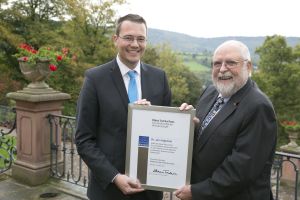For the clear description of his research work, Dr. Jan Ungelenk, who did his doctorate at the Karlsruhe Institute of Technology (KIT), is granted the Klaus Tschira Award for Understandable Science, KlarText!, in the category of chemistry. His doctoral thesis deals with tin tungstate as a photocatalyst. In a generally understandable article entitled “Chemie mit der Kraft der Sonne” (Chemistry with the power of the sun), Jan Ungelenk presents the results. The KlarText! awards will be handed over by Klaus Tschira on October 9, 16 hrs, at the Alte Aula of Heidelberg University.
The Klaus Tschira Foundation awards the prize in the categories of biology, chemistry, informatics, mathematics, neurosciences, and physics to young scientists, who wrote an outstanding doctoral thesis in the previous year and who succeeded in presenting the results in a generally understandable article of about three pages. Every KlarText! winner receives a sum in the amount of EUR 5000. All six prize-winning contributions are published in a supplementary issue of the popular science magazine bild der wissenschaft.
In his article “Chemie mit der Kraft der Sonne” (Chemistry with the power of the sun), Dr. Jan Ungelenk describes the search for a new material, by means of which sunlight can be used much more efficiently for chemical reactions than before. Such a photocatalyst that can use visible light is of interest to medical applications among others. In theory, tin tungstate appeared to be a suitable candidate. With the help of a trick, Jan Ungelenk for the first time succeeded in producing yellow tin tungstate at a low temperature and a so far unmatched quality. This yellow tin tungstate possesses photocatalytic properties and is up to 16 times more active under simulated sunlight than titanium dioxide that is the most frequently applied photocatalyst today. In a cooperation project, a working group headed by PD Dr. Ute Schepers, KIT, demonstrated that yellow tin tungstate destroys human liver cancer cells when exposed to blue light. In his article, Jan Ungelenk describes his research work in a generally understandable way and clearly explains all scientific terms. He succeeds in maintaining the suspense arc from the beginning to the end.
Jan Ungelenk, who was born in 1985, studied nanostructure and molecular sciences at the University of Kassel. He wrote his diploma thesis at the Center for Solar Energy and Hydrogen Research Baden-Württemberg in Stuttgart. His doctoral thesis written at the KIT and entitled “Zinnwolframat – ein solar aktivierbarer Fotokatalysator und Übergangsmetallwolframate als nanoskalige Funktionsmateria-lien” (Tin tungstate – a solar activable photocatalyst and transition metal tungstates as nanoscaled functional materials) was supervised by Professor Claus Feldmann. It was given the grade summa cum laude. For his doctoral thesis, Jan Ungelenk received the 2013 Environmental Award of the Sparkasse Karlsruhe Ettlingen. Since March 2014, he has been working as a laboratory director (oxidation catalysis) with BASF SE, Ludwigshafen.
The Klaus Tschira Foundation supports natural sciences, mathematics, and informatics and the public appreciation of these subjects. To strengthen the skills of communicating science, the Foundation, together with the KIT, established the National Institute for Science Communication (NaWik) in Karlsruhe.
The other winners of the 2014 Klaus Tschira Award for Understandable Science are Dr. Karen Linnemannstöns (biology, Universität Göttingen), Dr. Sebastian Trimpe (informatics, ETH Zurich), Dr. Jannik Matuschke (mathematics, TU Berlin), Dr. Katja Franke (neurosciences, University of Zurich), and Dr. Benjamin Thaidigsmann (physics, Universität Tübingen). The winners are free to apply for further funding of science communication projects by the Foundation. In total, 170 young scientists applied for the 2014 Klaus Tschira Award. All of them may join a workshop of two days’ duration on science communication in Heidelberg organized by the Foundation.
Photos of the award winners may be obtained at http://www.klaus-tschira-preis.info/presse.php. The price-winning contributions and the complete KlarText! special issue are available at http://www.klaus-tschira-preis.info/bdwdownload.php
In close partnership with society, KIT develops solutions for urgent challenges – from climate change, energy transition and sustainable use of natural resources to artificial intelligence, sovereignty and an aging population. As The University in the Helmholtz Association, KIT unites scientific excellence from insight to application-driven research under one roof – and is thus in a unique position to drive this transformation. As a University of Excellence, KIT offers its more than 10,000 employees and 22,800 students outstanding opportunities to shape a sustainable and resilient future. KIT – Science for Impact.

